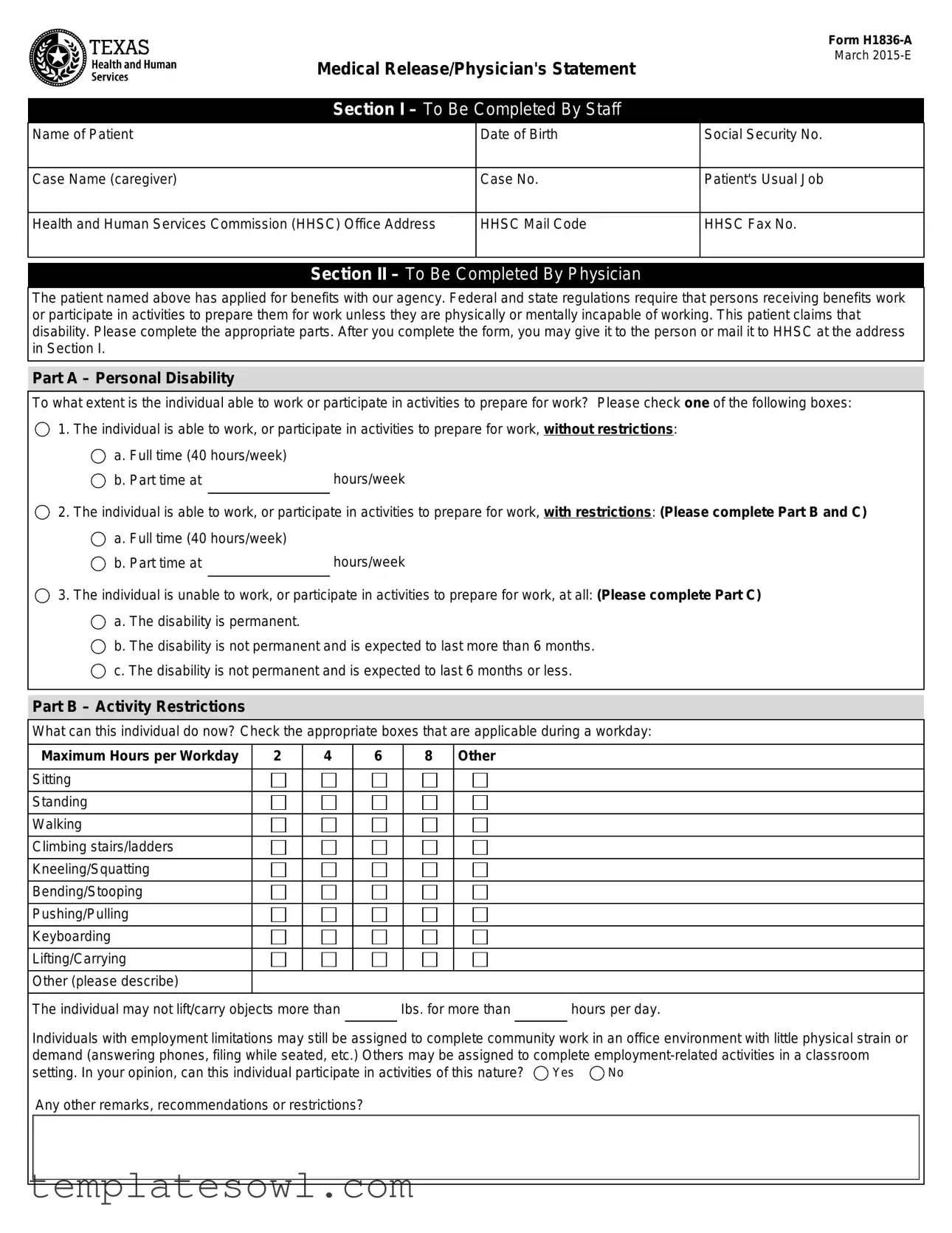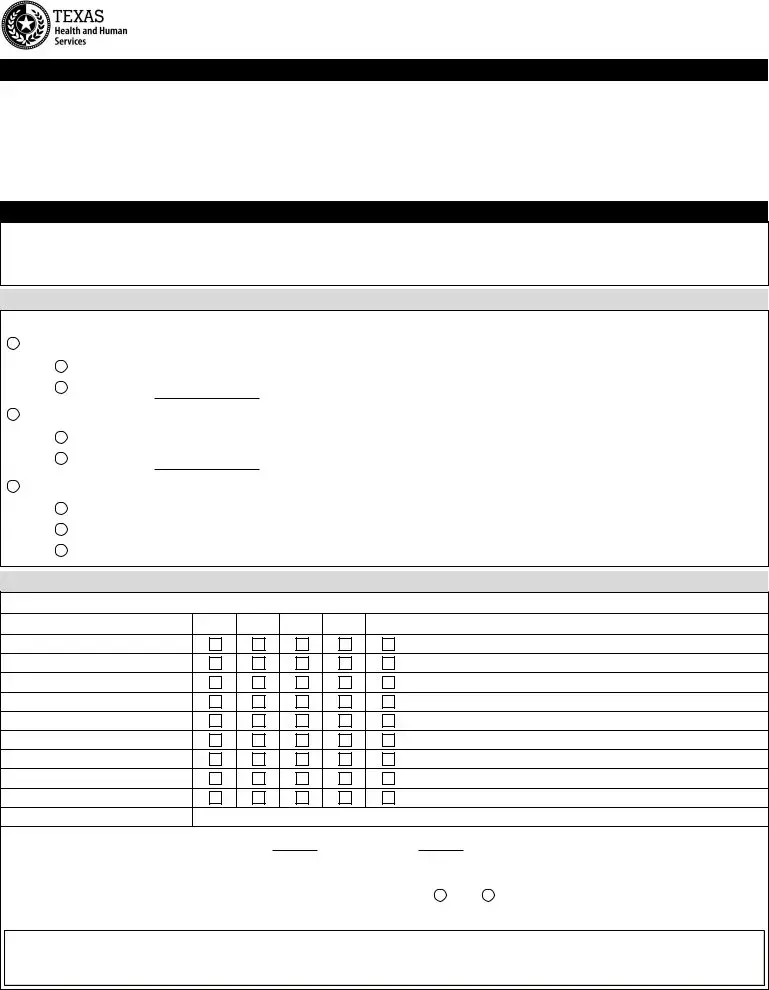Medical Release/Physician's Statement
Form H1836-A
March 2015-E
Section I – To Be Completed By Staff
Name of Patient |
Date of Birth |
Social Security No. |
|
|
|
Case Name (caregiver) |
Case No. |
Patient's Usual Job |
|
|
|
Health and Human Services Commission (HHSC) Office Address |
HHSC Mail Code |
HHSC Fax No. |
|
|
|
Section II – To Be Completed By Physician
The patient named above has applied for benefits with our agency. Federal and state regulations require that persons receiving benefits work or participate in activities to prepare them for work unless they are physically or mentally incapable of working. This patient claims that disability. Please complete the appropriate parts. After you complete the form, you may give it to the person or mail it to HHSC at the address in Section I.
Part A – Personal Disability
To what extent is the individual able to work or participate in activities to prepare for work? Please check one of the following boxes:
1. The individual is able to work, or participate in activities to prepare for work, without restrictions:
a. Full time (40 hours/week) |
|
b. Part time at |
hours/week |
2. The individual is able to work, or participate in activities to prepare for work, with restrictions: (Please complete Part B and C)
a. Full time (40 hours/week) |
|
b. Part time at |
hours/week |
3. The individual is unable to work, or participate in activities to prepare for work, at all: (Please complete Part C)
a. The disability is permanent.
b. The disability is not permanent and is expected to last more than 6 months.
c. The disability is not permanent and is expected to last 6 months or less.
Part B – Activity Restrictions
What can this individual do now? Check the appropriate boxes that are applicable during a workday:
Maximum Hours per Workday |
2 |
4 |
6 |
8 Other |
Sitting
Standing
Walking
Climbing stairs/ladders
Kneeling/Squatting
Bending/Stooping
Pushing/Pulling
Keyboarding
Lifting/Carrying
Other (please describe)
The individual may not lift/carry objects more than Ibs. for more than hours per day.
Individuals with employment limitations may still be assigned to complete community work in an office environment with little physical strain or demand (answering phones, filing while seated, etc.) Others may be assigned to complete employment-related activities in a classroom
setting. In your opinion, can this individual participate in activities of this nature? |
Yes |
No |
Any other remarks, recommendations or restrictions?
Form H1836-A
|
|
|
|
Page 2 / 03-2015-E |
|
|
|
|
|
Part C – Diagnosis |
|
|
|
|
Primary Disabling Diagnosis |
|
|
Secondary Disabling Diagnosis |
|
|
|
|
|
|
Comments |
|
|
|
|
|
|
|
|
Name of Physician (please type or print) |
Signature – Physician |
Date |
|
|
|
|
Physicians License No. |
Office Address (Street or P.O. Box, City, State and ZIP) |
Area Code and Phone No. |
|
|
|
|
|
Section III – To Be Completed By Patient or Patient's Personal Representative
Authorization to Release Medical Information
Patient's Name:
HHSC is requesting verification of the medical condition that prevents you from participating in the employment services program. When you sign this authorization, you are giving HHSC permission to contact your doctors, medical facilities or other health care providers to request copies of your health information as indicated below. You do not have to sign this form to be eligible for TANF, SNAP, or Medicaid. However, you must sign this form if you want to be eligible for an exemption from the employment services program.
I authorize |
|
to complete Form H1836-A, Medical Release/Physician's Statement, and |
|
|
|
|
Doctor, Medical Facilities or other Health Care Providers |
release the information to HHSC and the Texas Workforce Commission for purposes of verifying the medical condition that prevents me from
participating fully in the employment services program. This authorization expires on |
. |
|
|
|
|
|
|
|
|
|
|
|
|
|
Client or Personal Representative's Signature |
|
|
|
Date |
If you are signing for the client, please describe your authority to act for the client: |
|
|
|
|
Note: If the person requesting the release of case information cannot sign his/her name, two witnesses to his/her mark (X) must sign below:
Witness |
Date |
Witness |
Date |
Notice to Client
HHSC, as receiver of this information, will protect your personal health information in accordance with federal and state privacy regulations. If you authorize release of your health information to other parties, it may no longer be protected by privacy regulations.
You can withdraw permission you have given your doctor or health care provider to use or disclose health information that identifies you, unless they have already taken action based on your permission. You must withdraw your permission in writing.


